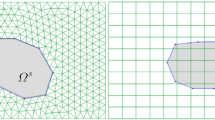Abstract
Continuum models of two-phase flows of solids and liquids use constitutive assumptions to close the equations. A more fundamental approach is a “molecular dynamic” simulation of flowing “big” particles based on reliable macroscopic equations for both solid and liquid. We developed a package that simulates the unsteady two-dimensional solid-liquid two-phase flows using the Navier-Stokes equations for the liquid and Newton's equations of motion for the solid particles. The Navier-Stokes equations are solved using a finite-element formulation and Newton's equations of motion are solved using an explicit-implicit scheme. We show that the simplest fully explicit scheme to update the particle motion using Newton's equations is unstable. To correct this instability we propose and implement and Explicit-Implicit Scheme in which, at each time step, the positions of the particles are updated explicitly, the computational domain is remeshed, the solution at the previous time is mapped onto the new mesh, and finally the nonlinear Navier-Stokes equation and the implicitly discretized Newton's equations for particle velocities are solved on the new mesh iteratively. The numerical simulation reveals the effect of vortex shedding on the motion of the cylinders and reproduces the drafting, kissing, and tumbling scenario which is the dominant rearrangement mechanism in two-phase flow of solids and liquids in beds of spheres which are constrained to move in only two dimensions.
Similar content being viewed by others
References
Avalosse, Th., Couniot, A., and Crochet, M.J. (1990), Finite element simulation of compounding in domains of arbitrary shape, Private communication.
Batchelor, G.K. (1967),An Introduction to Fluid Dynamics, Cambridge University Press, Cambridge.
Couniot, A., Dheur, L., Hansen, O., and Dupret, F. (1989), A finite element method for simulating injection molding of thermoplastics,Proc. NUMIFORM '89 Conf., Fort Collins, 26–30 June 1989, pp. 235–241, Balkema, Rotterdam.
Crochet, M.J., Debaut, B., Keunings, R., and Marchal, J.M. (1991), A finite element program for modelling processes, inCAE for Polymer Processing: Application in Extrusion and Other Continuous Processes, K.T. O'Brian, ed., Hanser Verlag, Munchen.
Cuthill, E., and McKee, J.M. (1969), Reducing the bandwidth of sparse symmetric matrices,Proc. 24th Nat. Conf. of the Association for Computing Machinery, p. 69
Fortes, A.F., Joseph, D.D., and Lundgren, T.S. (1987), Nonlinear mechanics of fluidization of beds of spherical particles,J. Fluid Mech.,177 467–483.
Hecht, F., and Saltel, E. (1989), Emc2 un logiciel d'édition de maillages et de contours bidimensionels, Rapport, INRIA.
Milne-Thomson, L.M. (1960),Theoretical Hydrodynamics, Macmillan, New York.
Swanson, W.M. (1970),Fluid Mechanics, Holt, Rinehart and Winston, New York, Section 11.5.
Tezduyar, T.E., Liou, J., and Behr, M. (1990a), A new strategy for finite element computations involving moving boundaries and interfaces—the DSD/ST procedure: I. The concept and the preliminary numerical tests. Supercomputer Institute Research Report UMSI 90/169, University of Minnesota, to appear inComput. Methods Appl. Mech. Engrg.
Tezduyar, T.E., Liou, J., Behr, M., and Mittal, S. (1990b), A new strategy for finite element computations involving moving boundaries and interfaces—the DSD/ST procedure: II. Computation of free-surface flows, two-liquid flows, and flows with drafting cylinders. Supercomputer Institute Research Report UMSI 90/170, University of Minnesota, to appear inComput. Methods Appl. Mech. Engrg.
Author information
Authors and Affiliations
Additional information
Communicated by M.Y. Hussaini
This work was supported by the National Science Foundation, the Department of Energy, and the Army Research Office, Mathematics.
Rights and permissions
About this article
Cite this article
Hu, H.H., Joseph, D.D. & Crochet, M.J. Direct simulation of fluid particle motions. Theoret. Comput. Fluid Dynamics 3, 285–306 (1992). https://doi.org/10.1007/BF00717645
Received:
Accepted:
Issue Date:
DOI: https://doi.org/10.1007/BF00717645




